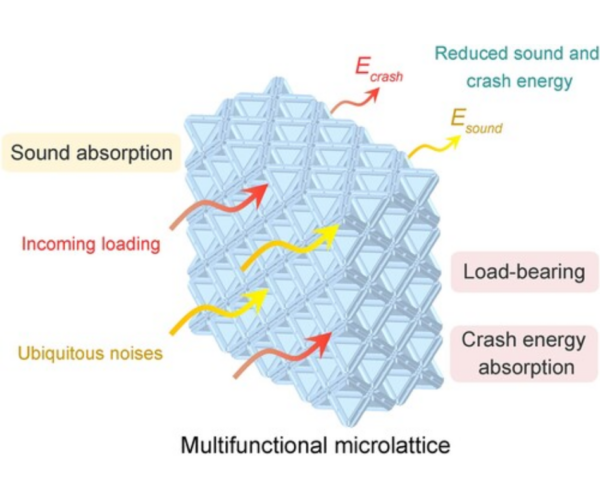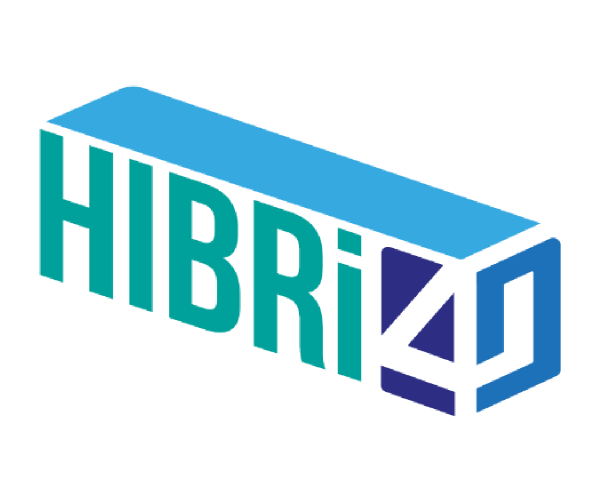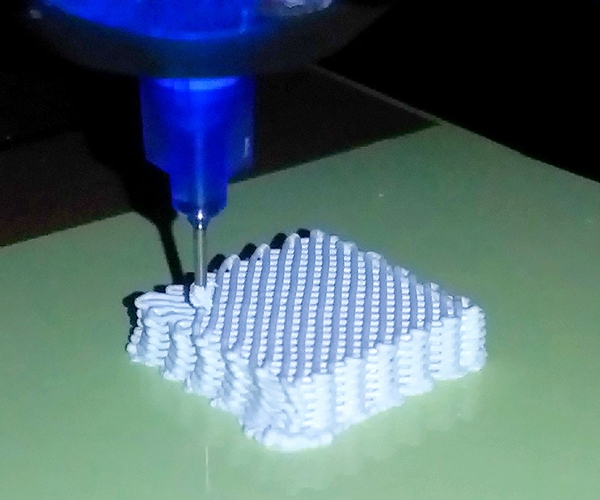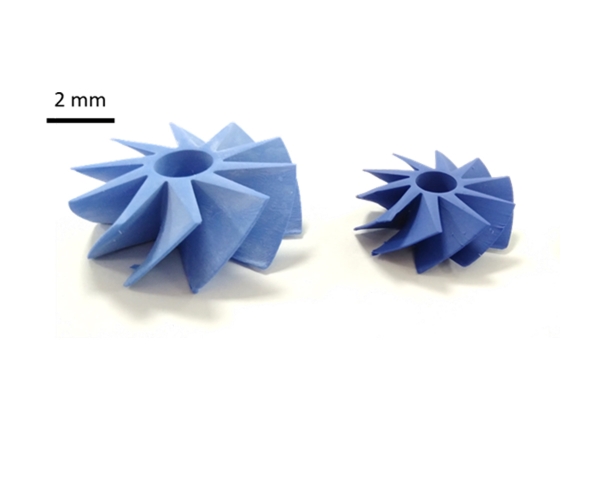
Conventional 3D printing technologies focus on the manufacture of CAD-modelled structures very often from a single material or materials of the same nature, without satisfying all the demands or advanced functionalities that Digital Manufacturing allows today.
Within the framework of consortium projects, the technical teams of the CIM UPC work together with researchers to materialize the technological needs that allow progress in the state of the art, co-creating bespoken machinery that make it easier for the research groups to stand out and progress.
Thus, equipment is developed by combining technologies of a different nature that allow production processes never before applied, such as multi-material extrusion, being able to merge a wide variety of different Additive Manufacturing technologies (vat photopolymerization, FFF, DIW, pellet extrusion, micro-extrusion of soft materials, etc.).
All this is complemented by a wide range of equipment for analysis and characterization of materials and products available at UPC: the projects carried out at the CIM UPC link the development of new equipment and processes with the essential validation of the prototypes that are obtained.
The objective is to obtain highly functional multi-material parts with a single additive manufacturing equipment for applications in different sectors (health, energy, industry…etc.) with a great impact on the current challenges of our society: the energy transition, the circular economy , sustainability, decarbonised mobility,…
The project proposes to reuse electrolytes at the end of its useful life to create a new material with advanced acoustic properties, using 3D printing technologies such as fDM, DIW and DIW + FDM. These technologies will allow the manufacture of metaporous surfaces with better acoustic properties. The final objective is to develop a material with acoustic performance and environmental impact, reducing CO2 emissions. Se utilizarán electrólitos sólidos reciclados, cumpliendo con la legislación ambiental, y se optimizarán geometrías complejas gracias a la impresión 3D para minimizar el uso de materiales vírgenes y conservar recursos naturales. The project will culminate by demonstrating the acoustic properties through a prototype tunnel ventilation silencer.

The FIReBone project aimed at personalized medicine aims to develop the equipment and methods for the manufacture of Functionalized and Approved Reticular Osse Grafts (IORFH) using Direct Ink Writing (DIW) technology. Additive manufacturing is a promising alternative, with DIW being a method with great potential in the biomedical sector due to its versatility for fish design, the type of printable material and the competitive cost of the equipment.
The main objective of the project is to make the process reliable and ensure the traceability of the IORFH in accordance with the standards of the biomedical sector. Another objective of this project is to develop reticular structures for porous implants subjected to mechanical load with the condition of maximizing the transmission of the load of the implant in the bone and improving its bioregenerative capacities.
Participants: AMES PM TECH; AMES Medical; UPC (Biomechanics and Engineering of Tissues-BBT); CIM
Project reference
CPP2021-008731
Program and call
“The publication/result/equipment/video/activity/contract/other is part of the project CPP2021-008731, financed by MCIN/AEI/10.13039/501100011033 and by the European Union “NextGenerationEU”/PRTR”.
Project financed by the MINISTRY OF SCIENCE AND INNOVATION within the framework of public aid for public-private collaboration projects, of the State Program to Promote Scientific-Technical Research and its Transfer, of the State Plan for Scientific, Technical and Innovation Research 2021 -2023, within the framework of the Recovery, Transformation and Resilience Plan, and by which the call for early processing corresponding to the year 2021 of these aids is approved.

VIVALDI responds to the growing demand for metal and ceramic powders, currently not available on the market, as a result of the rapid expansion of the AM sector. Currently, this demand is satisfied mainly from powders manufactured using gas atomization technologies, which generate a powder of adequate dimensions and quality, but at a high cost. The VIVALDI project arises from the need to find ways to obtain and use powders from recycled sources to improve the sustainability of the process, as well as reduce the cost of production.
This project will be carried out in a consortium of 6 SMEs covering the entire value chain. GRUPAL ART, BCIRCULAR, TMCOMAS, COLFEED,BCN3D and SAMYLABS. CIM UPC will contribute to the project all its knowledge about 3D printing of materials with a high metallic and ceramic load, as well as its know-how in the development of specialized advanced printing equipment. The project will have the collaboration of other research centers: Eurecat, CSIC-ICV and CSIC-CENIM.



The main objective of the HIBRI4D project focuses on the research and development of Multimaterial Additive Manufacturing (MMAM) technology, for the development of multimaterial/multifunctional smart parts and devices with embedded electronics and sensors in a single process; without the need for subsequent machining and post-processing for hybridization of components; thus expanding and strengthening one of the key technologies in Industry 4.0; for flexible, customized and automated production.
The HIBRI4D consortium is made up of a group of five SMEs, BCN 3D, EDSER LABS, Calçats HERGAR, SENSING TEX, and SMART MATERIAL. Likewise, the consortium has the external collaboration of technology centers and research groups specialized in additive manufacturing technologies: AIMPLAS, CTCR and CIM UPC.




The emerging group BASE3D, coordinated by the CIM UPC, is a group of research centres created to promote research, technological development and innovation in 3D Printing, and which has proposed to increase the TRL (Technology Readiness Level) of various lines manufacturing of additive manufacturing technologies, and that it will do so by executing projects that total a global investment of about € 3.7 million.
For this, 4 projects have been promoted:
- LIGHT3D: Laser and Other Light Technologies, led by LEITAT.
- FUSE3D: Technologies for semi-phase material deposition, led by HSJD.
- INK3D: Technologies for the deposition of continuous inks, led by the UPC BBT research group.
- HYBRI3D: Technologies for multi material hybridization, which we lead from the CIM UPC.
It is 50% co-financed by the European Regional Development Fund 2014-20 of Catalonia with the support of the Department of Research and Universities.


The FENIX project aims to study and develop a set of innovative business models, industrial strategies and supply chains based on the “circular life cycle” concept. The project will demonstrate how reclaimed materials will bring new value-added products to life through additive manufacturing.
The aim is to define more sustainable ways to develop, use and reintroduce whole products, components or materials within the supply chain, through the circular economy. From the CIM we contribute to this project the knowledge for the design, development and manufacture of additive manufacturing processes, focused on reducing operating costs and environmental impacts and on improving the performance of the processes.
Project Funded by the European Commission under the Horizon 2020 Framework Programme.
Grant Agreement ID: 760792

The AMFEED project studies new methods of manufacturing sintered porous components based on 3D printing techniques. The main objective of the project consists in the development of a new technological scientific knowledge, focused on additive manufacturing techniques, which allows obtaining metallic and ceramic parts characterized by a level of controlled porosity, and which are oriented to fields such as health or microelectronics.
Thanks to the use of the fused wire manufacturing technique (FFF) we can design and define, in a controlled way, the internal pore of the final piece, working with the internal composition of the material for compounding processes (degree of intrinsic porosity), thus such as internal holes/gaps derived from the layering itself and the strategies used.
Project reference
RTC-2017-6363-5
Program and call
Project funded by the MINISTRY OF SCIENCE, INNOVATION AND UNIVERSITIES and by the European Union, within the framework of the Call Challenges-Collaboration of the State Program for Research, Development and Innovation Oriented to the Challenges of Society, within the State Plan for Scientific Research and technical and innovation 2013-2016, with the main objective of promoting technological development, innovation and quality research.

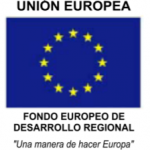
Transport project is framed within the community of Llavor 3D, which is driven by Generalitat the Catalunya to accelerate and develop the adaptation of additive manufacturing in the industrial sector and financed through the operational program ERDF Catalonia 2014-2020.
The objective of the project is to replace pieces of metallic base material for aluminium-plastic base material that alleviates the weight, improves the performance of the current components and entails a reduction in the cost of the raw material and the production process while preserving the physicochemical properties of the coating (transmission bars, fasteners, shock absorber shafts, etc.) through the application of AM / 3DP technologies. The transport industry, and even more so the rail industry, is very much oriented towards reducing costs. Especially on the tram and metro product lines, where there is a lot of competition.



